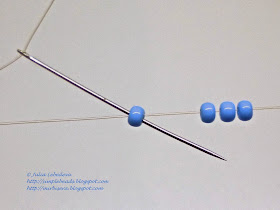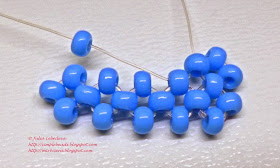We continue learning beading techniques. Today we will learn Right-Angle Weave stitch, also known as RAW. It is a bead weaving technique in which beads are stitched together with thread only making right angle turns. There are different kinds of RAW, such as flat right angle weave, tubular right angle weave and cubic right angle weave. At first, we will learn the basic kind of this stitch, flat right angle weave, and make a beaded fabric using this technique.
We will need:
- seed beads (I used size 8 seed beads);
- nylon fishing line and two beading needles (I used fishing line 0.3 mm in diameter).
Start weaving. Take a nylon fishing line about 1 m long with needles at both its ends. String 4 beads onto the line and place them on the middle of the line.
Take either end of the line and cross it through the extreme bead on the other end of the line.
Tighten the lines. We’ve got the 1st 4-bead unit.
Then string 2 beads onto either one of the lines and string 1 bead onto the other line.
Cross the line with 1 bead through the last bead added on the other line.
Tighten the lines. We’ve got the 2nd 4-bead unit.
Repeat the last step as many times as you need to reach the desired width for your piece. For this tutorial I made a section of five 4-bead units.
This section is the 1st row of the future beaded fabric.
Put this section on the worktable horizontally.
Start making the 2nd row. The 1st 4-bead unit of the 2nd row will be situated atop the last such a unit of the 1st row. That is why we need to pass the lines back around the ring of the last 4-bead unit and exit from the top bead of this unit. So, pass the upper line through the 1 bead only and pass the lower line through the 3 beads.
Then string 1 bead onto the line that points to the inner side of the beaded fabric
and string 2 beads onto the line that points outside.
After that cross this (outside) line through the bead at the other line
and pass this line further through the top bead of the next 4-bead unit of the previous row in a forward direction.
Tighten the lines. We’ve got the 1st 4-bead unit of the 2nd row.
Now we should pay attention to the fact that we already have two of four beads necessary to build the second 4-bead unit in this row. That is why we only need to add two beads this time. So, string 1 bead onto the lower line,
then string 1 bead onto the upper line
and cross this (upper) line through the bead at the other (lower) line
and further through the top bead of the next 4-bead unit of the previous row in a forward direction.
Tighten the lines. We’ve got the 2nd 4-bead unit of the 2nd row.
In the same way make two more 4-bead units in the row.
To make the last 4-bead unit of the 2nd row, string 1 bead onto the upper line,
then string 1 bead onto the lower line
and after that cross the lower line through the bead at the other line.
Pull the lines tight. The 2nd row is completed.
Repeat the pattern of the 2nd row and make as many rows as you need to reach the desired length. The below photo shows a beaded fabric of 11 rows (i.e. a fabric of 5x11 4-bead units).
In the next tutorials we will learn some other tricks of RAW beading stitch and after that we will make a beaded item using this technique.
P.S. If you like this tutorial, share it with your friends on social networks using the buttons below the post.
Don't want to miss new tutorials? Subscribe for email notifications of site updates or follow us on Twitter!


























The fifth image of the tutorial is confusing. You show the thread being put through beads from both ends, but don't specify which end of the thread is used. In the previous image one thread is shown, and in the next there are two threads. Where did it come from? Or does it not matter and you can use whichever end you want?
ReplyDeleteAfter making the 4-bead unit (the 3rd image of the tutorial) the ends of the thread come out from the upper bead of that 4-bead unit in different directions. At the next step you should string two beads onto the left end of the thread and one beads onto the right end of the thread (image 4). After that take the right end of the thread (with one bead on it) and pass it through the extreme bead on the left end of the thread (image 5). The upper thread and the right end of the thread in the fifth image are just the same. Hope, this explanation will help you.
Delete